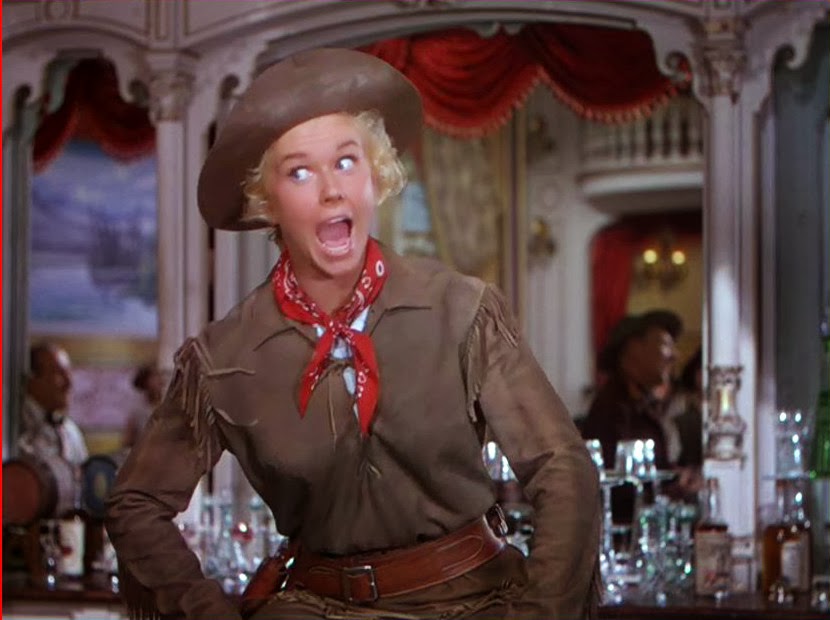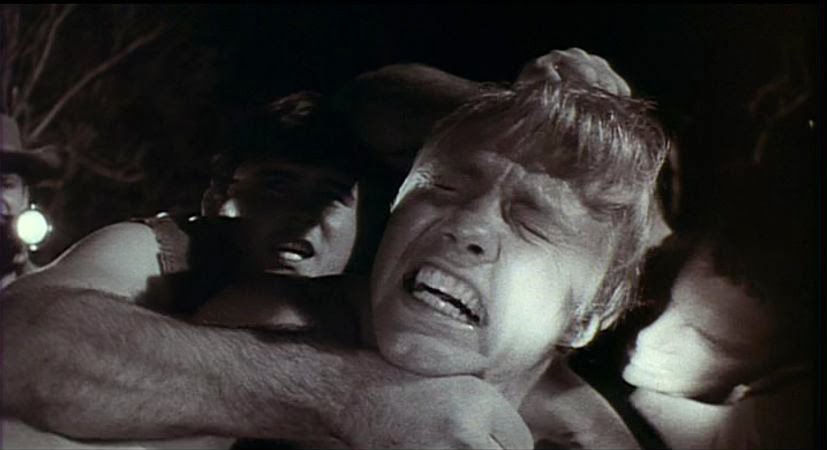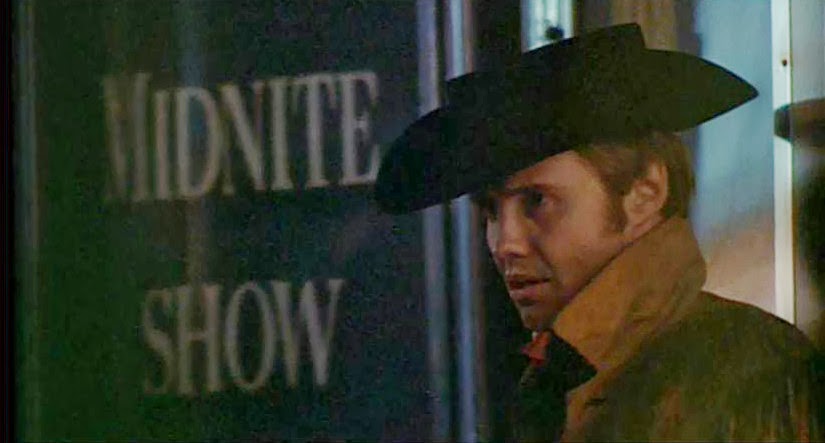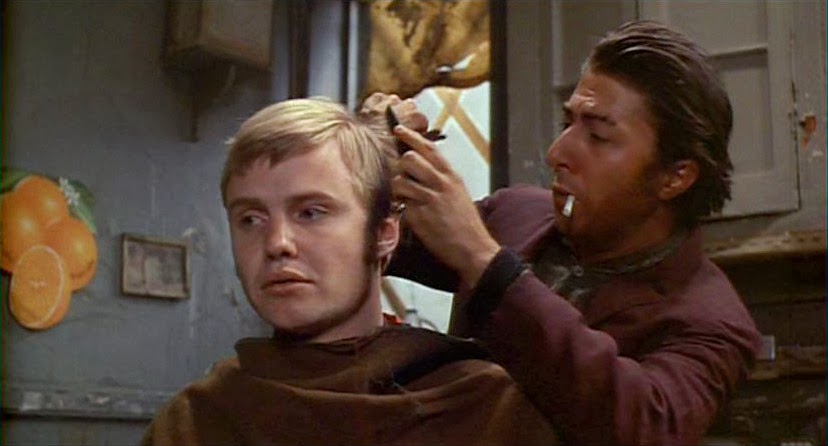When it comes to the preserved documentation of talent
squandered and the irrefutable evidence of an artist in decline, few actors
have as nagging a filmography as Richard Burton. And boy did he know it.
Indeed, it’s the occasion of my having just finished
reading (more like devouring) The Richard
Burton Diaries—wherein Burton attempts to rebuke the tiresome (to him) “myth”
that his career is one of unrealized potential incarnate—that inspired me to revisit this cult film curio from the “anything goes” '70s. Cult film in this
instance being the term applied to any movie of dubious merit for which one
harbors an affection that defies logical explanation.
In 1971, just before starting work on Bluebeard, Richard
Burton wrote: “My lack of interest in my own career—past, present, or future—is almost total. All my life I think I have been secretly ashamed of being an
actor. And the older I get, the more ashamed I get.”
Well, that explains a lot.
In fact, combined with the obvious allure of travel (the film was shot in Budapest, Hungary...a place the globe-trotting Burton had never visited) and a hefty
paycheck, only apathy, self-loathing, and a subconscious need to publicly
humiliate oneself can be the possible explanation for Burton’s head-scratching participation
in Bluebeard: a big-budget, yet awfully cheap-looking, black comedy/horror movie
that by rights should have been a throwaway exploitationer from Hammer Films starring
Christopher Lee or Vincent Price. In fact, Burton wrote of purposely hoping to
emulate Vincent Price in the role: “It has to be done with immense tongue-in-cheek. I will try
to remember how the master—whasssisname—Vincent Price plays it.”
Compared to the depths of degradation awaiting him with The Klansman (1974), Exorcist II: The Heretic (1976), and The Medusa
Touch (1977), Bluebeard actually represents something of late-career high-point for Burton, signifying as it does
a movie that, at least partially, intends to be laughed at.
 |
| Richard Burton as Baron Kurt Von Sepper |
 |
| Joey Heatherton as Anne |
Basically a Playboy magazine pictorial disguised as a film,
Bluebeard is a tongue-in-cheek, post-WWI retelling of the 17th-century
French folktale about a nobleman with a history of murdering his wives. Richard
Burton plays Austrian (I think) war hero and famed fighter pilot Kurt Von Sepper,
who, as the film begins, meets and hastily marries a spunky American cabaret performer named Anne, assayed—emphasis on the first syllable, if you get my cruder meaning—by '70s variety show stalwart, Serta mattress pitchwoman, and erstwhile Bob Hope USO Tour frug-er, Joey
Heatherton. True to the very grim original fairy tale, the Baron’s bride
soon comes to learn of the gruesome deaths of her six predecessors (and a stray prostitute,
for good measure) at the hands of her literally blue-bearded husband, and, over
the course of one very tense evening, is forced to rely on her wits(!) and assorted Scheherazadian ploys to avoid meeting a similar fate.
As movie set-ups go, this one isn't half bad. It's only in the execution (if you'll pardon the pun) where things start to go awry. The theme of the young wife suspecting her hubby of harboring a deep, dark secret has been used effectively in movies for ages. In The Stranger (1946) a slow-on-the-pickup Loretta Young discovers she's wed a Nazi (you'd think a little thing like that would have come up during courtship); in Conspirator (1949) teen bride Elizabeth Taylor learns much-too-old-for-her Robert Taylor is a Soviet spy; in the thriller Julie (1956), Doris Day weds a man who may or may not have killed her first husband (how inconvenient!); and Hitchcock requires Joan Fontaine to sleep with one eye open in both Rebecca (1940) and Suspicion (1941).
In this French/Italian/German production designed to showcase and undress its cast of international beauties, Miss Heatherton's unequivocal American-ness works rather well. Both as contrast (she has a delectably dissolute quality that makes her look like a debauched Sandra Dee) and in rendering her character believable as the one wife meddlesome enough to go snooping where she doesn't belong.
Richard Burton summed it up nicely: "Heatherton seems unbelievably ordinary, which might be good for the part. She has one of those one-on-every-corner, blonde, rather common, and at the drop of an insult I'm sure, rather bitchy faces."
Of course, top-billed Raquel Welch is also an American (total screen time: 8 minutes), but as Myra Breckinridge established, when Welch tries to be funny, she becomes so mannered and stilted that she barely even registers as human.
The device of having Heatherton forestall her execution by getting her homicidal husband to recount to her the whys and wherefores of each of his wives' deaths is also serviceable, for its fairy-tale framework is perfectly in keeping with Bluebeard's archly gothic tone, while the extensive use of lengthy flashbacks gives Bluebeard the feel of one of those jocular horror anthology movies popularized by Britain's Amicus Productions in the '70s (The House That Dripped Blood, Tales from the Crypt, The Vault of Horror, et al.).
Thus, with a solid horror film structure firmly in place and a script that asserts its dark/self-mocking humor at regular intervals, one would think that Bluebeard, in laying its "exploitation film" cards on the table, could effortlessly meet the low bar requirements it set for itself. Not so much.
After viewing Bluebeard, the impression one is left with is that the filmmakers are more than up to the task of producing a low-rent Eurotrash skin flick, but just don't have their hearts in the horror side of things. Blacklisted veteran director Edward Dmytryk, who clearly has seen better days (Murder My Sweet, Raintree County, The Caine Mutiny), has produced impressive work in many genres over the years, but demonstrates little of his flair here.
Obviously finding it difficult to sustain a consistent rhythm of comedy/horror, the overlong Bluebeard frequently shows the strain of having to keep its featherweight premise aloft for its hefty two-plus-hours running time. Since we usually know right away which fatal flaw Bluebeard will find in his wives, the drawn-out scenes of his slowly reaching the end of his rope feel like overlong setups for jokes to which we already know the punchline.
In these moments Dmytryk tends to undercut what little suspense there is by seeming to telegraph the denouements long before they actually occur. He out and out flubs even the most cliché tropes of the genre, such as in a scene where the shock reveal of a character thought to be out of the vicinity is botched entirely by having the camera placed practically across the room from the action. Equally problematic: it's hard to be induced to laugh at the exaggerated, purple performances Dmytryk elicits from his cast when one is not entirely sure: 1) They're in on the joke, 2) They're capable of better.
No, if Bluebeard can be accused of anything, it is of appearing to so aggressively court the lucrative softcore euro-sleaze exploitation market, it treats every scene which doesn't actively involve the gratuitous disrobing, display, or objectification of a pulchritudinous actress as necessary, but unwanted, filler.
As movie set-ups go, this one isn't half bad. It's only in the execution (if you'll pardon the pun) where things start to go awry. The theme of the young wife suspecting her hubby of harboring a deep, dark secret has been used effectively in movies for ages. In The Stranger (1946) a slow-on-the-pickup Loretta Young discovers she's wed a Nazi (you'd think a little thing like that would have come up during courtship); in Conspirator (1949) teen bride Elizabeth Taylor learns much-too-old-for-her Robert Taylor is a Soviet spy; in the thriller Julie (1956), Doris Day weds a man who may or may not have killed her first husband (how inconvenient!); and Hitchcock requires Joan Fontaine to sleep with one eye open in both Rebecca (1940) and Suspicion (1941).
In this French/Italian/German production designed to showcase and undress its cast of international beauties, Miss Heatherton's unequivocal American-ness works rather well. Both as contrast (she has a delectably dissolute quality that makes her look like a debauched Sandra Dee) and in rendering her character believable as the one wife meddlesome enough to go snooping where she doesn't belong.
Richard Burton summed it up nicely: "Heatherton seems unbelievably ordinary, which might be good for the part. She has one of those one-on-every-corner, blonde, rather common, and at the drop of an insult I'm sure, rather bitchy faces."
 |
| Raquel Welch as Magdalena, the nymphomaniacal nun. Wife #4 |
The device of having Heatherton forestall her execution by getting her homicidal husband to recount to her the whys and wherefores of each of his wives' deaths is also serviceable, for its fairy-tale framework is perfectly in keeping with Bluebeard's archly gothic tone, while the extensive use of lengthy flashbacks gives Bluebeard the feel of one of those jocular horror anthology movies popularized by Britain's Amicus Productions in the '70s (The House That Dripped Blood, Tales from the Crypt, The Vault of Horror, et al.).
Thus, with a solid horror film structure firmly in place and a script that asserts its dark/self-mocking humor at regular intervals, one would think that Bluebeard, in laying its "exploitation film" cards on the table, could effortlessly meet the low bar requirements it set for itself. Not so much.
 |
| Karin Schubert as Greta, the patient virgin. Wife #1 |
Obviously finding it difficult to sustain a consistent rhythm of comedy/horror, the overlong Bluebeard frequently shows the strain of having to keep its featherweight premise aloft for its hefty two-plus-hours running time. Since we usually know right away which fatal flaw Bluebeard will find in his wives, the drawn-out scenes of his slowly reaching the end of his rope feel like overlong setups for jokes to which we already know the punchline.
In these moments Dmytryk tends to undercut what little suspense there is by seeming to telegraph the denouements long before they actually occur. He out and out flubs even the most cliché tropes of the genre, such as in a scene where the shock reveal of a character thought to be out of the vicinity is botched entirely by having the camera placed practically across the room from the action. Equally problematic: it's hard to be induced to laugh at the exaggerated, purple performances Dmytryk elicits from his cast when one is not entirely sure: 1) They're in on the joke, 2) They're capable of better.
 |
| Nathalie Delon (l.) as Erika, the latent lesbian babytalker. Wife #3 With her, Sybil Danning (r.) as a helpful prostitute |
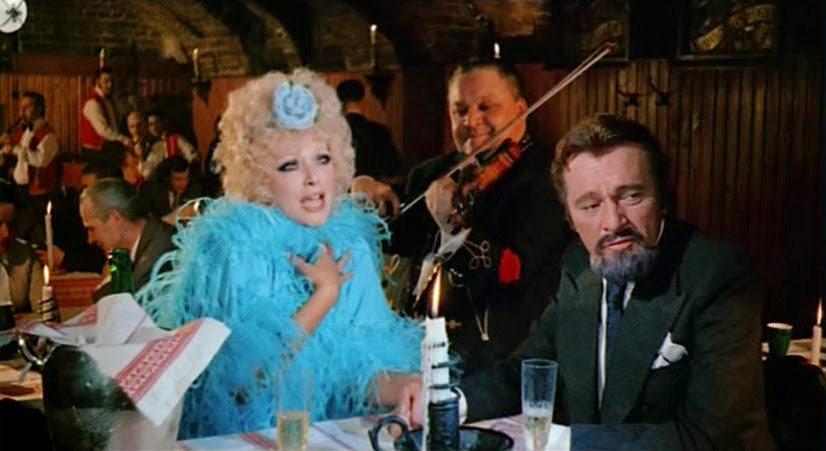 |
| Virna Lisi as Elga, the atonal songbird. Wife #2 |
WHAT I LOVE ABOUT THIS FILM
It’s a strange thing indeed to find oneself drawn to a film
specifically because of the disaster potential inherent in the collective interaction
of its assembled particulars. I submit for your approval: A once-respected, bomb-prone, alcoholic Shakespearean actor not known for either his dramatic restraint or light touch
with comedy; a legendarily "difficult," not excessively talented, reigning global sex goddess trying hard to hold onto the title
after a string of notable flops; a pouty American perpetual motion machine and heir
to the sex-kitten throne after Ann-Margret abdicated with Carnal Knowledge; a bevy of international "actresses" of varying
degrees of stateside recognizability (translated: the more obscure the actress,
the more extensive the nudity); and a director in his 60s taking a
whack (pun again?) at trendy '70s permissiveness. All converging in a genre of film—an arch, basic black comedy and gothic horror movie gumbo—alien to everyone involved.
 |
| Marilu Tolo as Brigitt, the masochistic feminist. Wife #5 |
| Agostina Belli as Caroline, the dispassionate free spirit. Wife # 6 |
PERFORMANCES
Although the lovely Nathalie Delon gives what I think is Bluebeard's best performance (she was the only wife I was sorry to see go), and the stunning Virna Lisi the most beautiful (that she allows her beauty to be camouflaged by costuming and makeup designed to emphasize the ridiculousness of her character, perhaps speaks well of the actress' lack of ego and sense of humor); I have to say that I am thoroughly charmed by Joey Heatherton in this and she is my absolute favorite performer in the film.
 |
| Dream Project Never to Be: A film of Chekhov's Three Sisters starring Joey Heatherton, Tuesday Weld, and Connie Stevens |
With that perpetually open-mouthed, sex-haze look she falls back on whenever she finds herself at a loss for character motivation, Heatherton can be downright dreadful at times. But she also possesses that intangible, alchemic "something" that transforms bad acting, mediocre dancing, and a narcissistic self-absorption, into a special kind of camp, star quality.
Looking amazing and photographed most flatteringly (she first worked with Bluebeard director Edward Dmytryk in 1964s Where Love Has Gone), Heatherton may have you shaking your head in wonder as you see her dressed in a collection of anachronistic frocks better suited to one of her Hullabaloo TV appearances, but she nevertheless reveals a comic talent for the sarcastic throwaway line, imbues the sometimes sluggish film with a considerable amount of misdirected, giggle-inducing energy, and ultimately emerges the real star of Bluebeard. Oh, and did I mention she goes topless?
As Bluebeard, the man who invented Your-Fault divorce, Richard Burton is certainly game, and sometimes even appears to be enjoying hamming it up. But it's hard to laugh at an actor of his stature actually trying to emulate Vincent Price (who is the master of this sort of thing, but it IS this sort of thing). His Bluebeard doesn't really have any madness at his core. In fact, in too many scenes Burton appears to be either drunk, distracted, or bored...take your pick.
 |
| Edward Meeks as Sergio, Anne's unlikely partner in her cabaret act |
THE STUFF OF FANTASY
Contemporary horror fans discovering Bluebeard are likely to find both the nudity and gore of this R-rated film to be well below even PG standards. But as for me, not having been weaned on Saw or whatever brand of torture porn passes for horror these days, I don't mind a bit that, outside of a pretty unwatchable hunting scene, the violence in Bluebeard is pretty bloodless.
 |
| Mathieu Carriere as the mysterious character known only as The Violinist |
 |
"Oh, I love the castle! I love the park.
The woods. These curtains. These walls. The furniture. I even like these
strange photographs!" Joey Heatherton, folks.
|
THE STUFF OF DREAMS
When Bluebeard was
first released, both Burton and Dmytryk went out of their way informing/warning everyone that
the film was intended solely as a lark and a laugh (as if anyone seeing a movie
titled Bluebeard [starring an actor wearing
a literal blue beard] could mistake it for anything else). When critics and
audiences failed to find much comedy, black or otherwise, in the sadism of the violence
directed toward women; little humor in the grim choice of anti-Semitism and neo-Nazi
fascism as a backstory plot point; and sat stone-faced at images of real-life animal
slaughter in the hunting scene, their complaints were summarily dismissed as
being born of taking it all too seriously, missing the point, and failing to understand
that the movie was…here we go again…a black comedy designed as escapist entertainment.
 |
| Von Sepper gets it in die nüsse |
Researching Bluebeard online, I read several reviews by individuals citing many of the above reasons for why they didn't ultimately enjoy the film. Of course, this being the internet, those observations were met with caustic rejoinders citing said reviewer's inability to understand the film's satirical intentions, or claims that the disapproving soul simply took it all too seriously.
 |
| Anne attempts to distract Von Sepper with a delicious dessert |
Well, just because something isn't "serious" doesn't mean it can't be deeply offensive. Indeed, when it comes to depictions of violence toward women, cruelty to animals, and a certain casual attitude regarding our culture of oppression; the inability to take any of it seriously can be precisely what lies at the core of its distastefulness.
As comedian Ricky Gervais said (Oh god, I'm quoting Ricky Gervais...and using the word god in the bargain): "Just because you're offended doesn't mean you're right." And on the topic of reacting to potentially incendiary films, maybe I should add to that: Just because you take no offense doesn't instantly imbue you with the benefit of having a more profound understanding of the content. No movie worth its salt doesn't divide audiences.
I think that Bluebeard is a great deal of gaudy, campy fun. A real "only in the '70s" oddity that is definitely worth a look, but for many, it's not even that. In spite of how entertaining I find it to be, I'm aware that it is very much a dated relic of a time when male-centric Hollywood sought to counter the cultural one-two punch of Women's Lib and the sexual revolution with movies that were troublingly anti-woman (Roger Vadim's repellent Pretty Maids All in a Row [1971] being the worst offender).
Richard Burton would go on to embarrass himself onscreen for years to come, his rare, first-rate performances in films like Equus (1977) and 1984 (1984) reminding us just how good he can be when he tries. Meanwhile, Joey Heatherton made a lot of camp film lovers' dreams come true when she appeared as Joe Dallesandro's wife in John Waters' Cry Baby (1990), her last film to date.
So, if you're inspired by this post to give Bluebeard a look, please proceed with caution.
And be very, very afraid...
BONUS MATERIAL:
See Joey Do Her Thing!
A mouth-watering collection of fantabulous Joey Heatherton variety show clips from the '60s and '70s await you on YouTube.
Joey's Best Performance.
In 1986 Joey Heatherton was acquitted on charges of having assaulted a passport office official. Heatherton should consider the verdict her unofficial Oscar for the absolutely incredible impersonation she does of her accuser. Her entire film career might have taken a totally different turn had she infused her performances with this much character detail. Here.























